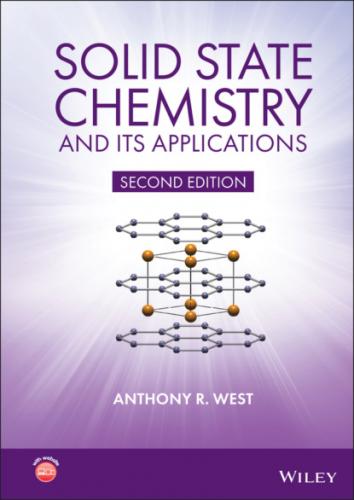7 Chapter 7Table 7.1 Densities of SiO2 polymorphs Table 7.2 Classification of phase transitions Table 7.3 Characteristics of some first‐order phase transitions Table 7.4 Some pressure‐induced phase transitions Table 7.5 Factors that influence kinetics of phase transitions
8 Chapter 8Table 8.1 Typical values of electrical conductivity Table 8.2 Conductivities of some metals at 25 °C Table 8.3 Some superconducting materials Table 8.4 Typical values of v d and v t for n‐type Si at 25 °C...Table 8.5 Conductivity in NaCl crystals, other ionic solids and characteris...Table 8.6 Some oxygen partial pressures at which and Table 8.7 Electrode potentials of some half‐reactions associated with lithi...Table 8.8 Terminology and units used with dielectrics Table 8.9 Some ferroelectric materials
9 Chapter 9Table 9.1 Magnetic susceptibilities Table 9.2 Some Curie and Néel temperatures Table 9.3 Calculated and observed magnetic moments (BM) for some transition...Table 9.4 Some soft and hard magnetic materials Table 9.5 Electronic constitution of iron, cobalt and nickel
10 Chapter 10Table 10.1 Activators and their electronic states Table 10.2 Some lamp phosphor materials Table 10.3 Some laser systems
11 Chapter 11Table 11.1 Homogeneous and heterogeneous materials, their properties and so...Table 11.2 Capacitance values* and their possible interpretation
12 Chapter 12Table 12.1 Thermoelectric coefficients Table 12.2 The thermoelectric series; emf values against Pt at 100 °C with ...Table 12.3 Some heat capacity, thermal conductivity and thermal expansion d...
13 Chapter 13Table 13.1 Some MAX precursors and their MXene products Table 13.2 Properties of some single layer TMDs
14 Chapter 14Table 14.1 Glass transition temperatures T g (measured) and T 0 (calculated...Table 14.2 Classification of glass‐forming materials by the type of bonding...Table 14.3 Some differences between spinodal and nucleation and growth text...
15 Chapter 15Table 15.1 Oxide and phase content of a typical Portland cement
16 Appendix GTable G.1 Electrode potentials
List of Illustrations
1 Chapter 1Figure 1.1 (a) Section through the NaCl structure, showing (b–e) possible re...Figure 1.2 Cubic unit cell of NaCl, a = b = c. Figure 1.3 (a) The seven crystal systems and their unit cell shapes; (b) fiv...Figure 1.4 (a) Threefold and (b) twofold rotation axes; (c) the impossibilit...Figure 1.5 Two‐dimensional Penrose tiling constructed by packing together tw...Figure 1.6 Hypothetical twinned structure showing fivefold symmetry. Figure 1.7 Symmetry elements: (a) mirror plane; (b) centre of symmetry; (c) ...Figure 1.8 Arrangement of coins with heads (H) and tails (T) illustrating (a...Figure 1.9 (a) Two‐, three‐ and fourfold axes and (b, c) mirror planes of a ...Figure 1.10 (a) Tetragonal unit cell of CaC2: note the cigar‐shaped carbide ...Figure 1.11 Representation of (a) the NaCl structure in two dimensions by (b...Figure 1.12 The unit cells of the 14 Bravais lattices: axes refer to the ab ...Figure 1.13 (a) Lattice planes (in projection); (b) derivation of Miller ind...Figure 1.14 Miller indices for a hexagonal lattice. Figure 1.15 Examples of Miller indices: (a) (101); (b) (100); (c) (200); (d)...Figure 1.16 (a) A cp layer of equal‐sized spheres; (b) a non‐cp layer with c...Figure 1.17 Two cp layers arranged in A and B positions. The B layer occupie...Figure 1.18 Three close packed layers in ccp sequence. Figure 1.19 Coordination number 12 of shaded sphere in (a) hcp and (b) ccp s...Figure 1.20 Face centred cubic, fcc, unit cell of a ccp arrangement of spher...Figure 1.21 (a, b) Hexagonal unit cell of an hcp arrangement of spheres show...Figure 1.22 (a) Unit cell dimensions for a face centred cubic unit cell with...Figure 1.23 Tetrahedral and octahedral sites between two cp anion layers, se...Figure 1.24 Available cation sites, 1–12, in an fcc anion array. Figure 1.25 (a, b) Tetrahedral sites T+, T– and their relation to a cube. (c...Figure 1.26 (a) hcp arrangement of Br atoms in crystalline Al2Br6; (b) Al at...Figure 1.27 (a) The C60 molecule; one pentagon surrounded by five hexagons i...Figure 1.28 Cation–cation separation in octahedra which share (a) corners an...Figure 1.29 Unit cell of (a, d) NaCl, (b, e) ZnS, sphalerite, and (c, f) Na2...Figure 1.30 Alternative view of the antifluorite structure. Figure 1.31 Unit cell of the rock salt structure showing edge‐sharing octahe...Figure 1.32 The rock salt structure as an array of edge‐sharing octahedra....Figure 1.33 The sphalerite (zinc blende) structure showing (a) the unit cell...Figure 1.34 The antifluorite structure of Na2O showing the unit cell in term...Figure 1.35 The wurtzite and nickel arsenide structures: (a–c) the hexagonal...Figure 1.36 The primitive cubic unit cell of CsCl. Figure 1.37 The rutile structure, TiO2: (a) the unit cell; (b) TiO6 octahedr...Figure 1.38 (a) Octahedral sites in an ideal hcp array; (b) edge‐sharing oct...Figure 1.39 The CdI2 structure: (a) the basal plane of the hexagonal unit ce...Figure 1.40 The CdCl2 structure. Figure 1.41 (a–d) The perovskite structure of SrTiO3. (e) A close packed Sr,...Figure 1.42 (a) Crystal structure of CaCu3Ti4O12. (b) The brownmillerite ...Figure 1.43 The structure of (a) ReO3, (b) tungsten bronze NaxWO3, (c, d) br...Figure 1.44 Representative parts of the spinel structure. (a) One octant of ...Figure 1.45 Olivine structure of LiFePO4. Figure 1.46 Crystal structures of (a) corundum, (b) ilmenite and (c, d) LiNb...Figure 1.47 Some cation‐ordered fluorites showing cation positions relative ...Figure 1.48 The pyrochlore structure, which may be regarded as a distorted, ...Figure 1.49 The garnet crystal structure. Figure 1.50 (a) The K2NiF4 structure. (b) The Bi2O2 layers that form part of...Figure 1.51 The crystal structure of MgB2 as (a) an oblique projection showi...Figure 1.52 Silicate anions with (a) bridging and (b) non‐bridging oxygens. ...Figure 1.53 The point groups (a, b) 2, (c, d) 3, and (e–h) m. Figure 1.54 The point groups (a)
